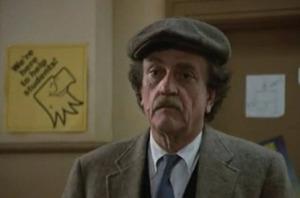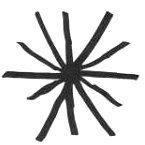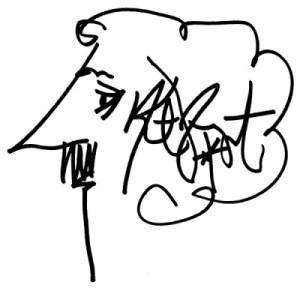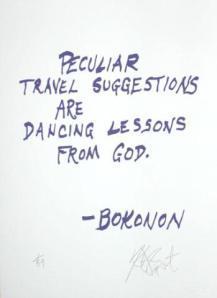I’m not sure that it ranks as high as pictures of baby animals, meme-based quizzes, “infotainment” listicles, or Kim Kardashian’s prodigious rump, but Kurt Vonnegut’s very name seems to have become a powerful form of clickbait in the twenty-first century. Judging from my own Facebook feed, there must be weekly (if not almost daily) blog posts or internet articles citing the wit and wisdom of the great Hoosier novelist. Vonnegut’s birthday on November 11 – serendipitously, it coincides with Armistice Day, otherwise known as Remembrance Day, but in the United States (and to Vonnegut’s dismay) it is now called Veteran’s Day – occasioned another wave of links crashing upon my social media screens, including this one, bizarrely titled “So It Goes: A Life of Guidance from Kurt Vonnegut in 11 Quotes.” As with other such worshipful pieces, all of the quotations are taken completely out of context, but errant web-surfers apparently find his words all the more meaningful, inspiring, or “guiding” for their being context-less. It matters little that Vonnegut was writer who consistently lamented the loss of memory and who derogated the false promise of an afterlife, particularly when he is being memorialized on the internet in such a way as to reinforce the memory-loss and to celebrate immortality. More than seven years after his death and more than 45 years after the publication of his most famous novel, Vonnegut lives a vibrant, seemingly eternal life as a ghostly but wise internet presence. Hi ho!
 For Vonnegut fans, the author’s virtual afterlife might be gratifying, as it justifies their own fandom and lends support to the view that Vonnegut, despite appearances, remains a timely figure whose sage wisdom is perfectly suited to our perilous, uncertain times. (Although, as Vonnegut himself might have noted, all times that can be labeled “the present” are equally perilous and uncertain.) Vonnegut scholars, as distinct from fans, are more apt to be dismayed by the outsized and artificial figure of the pop-culture Kurt, whose guru-like status among these consumers of dime-store philosophy and BuzzFeed-styled advertising-posing-as-thoughtful-reflection clearly betrays Vonnegut’s own caveats about gurus, every single one of whom are mountebanks, grifters, confidence men, or worse … politicians.
For Vonnegut fans, the author’s virtual afterlife might be gratifying, as it justifies their own fandom and lends support to the view that Vonnegut, despite appearances, remains a timely figure whose sage wisdom is perfectly suited to our perilous, uncertain times. (Although, as Vonnegut himself might have noted, all times that can be labeled “the present” are equally perilous and uncertain.) Vonnegut scholars, as distinct from fans, are more apt to be dismayed by the outsized and artificial figure of the pop-culture Kurt, whose guru-like status among these consumers of dime-store philosophy and BuzzFeed-styled advertising-posing-as-thoughtful-reflection clearly betrays Vonnegut’s own caveats about gurus, every single one of whom are mountebanks, grifters, confidence men, or worse … politicians.
Like any writer, of course, Vonnegut craved an audience. He wanted to be taken seriously, perhaps more than ever when he was joking. But what he has mostly received from his many fans in the internet age is adulation, adoration, and even various forms of tribal worship. The website of The Kurt Vonnegut Memorial Library, a marvelous shrine in the novelist’s erstwhile hometown Indianapolis, features photographs of Vonnegut-inspired tattoos, emblazoned into the flesh of his zealous acolytes, for instance. Not that there’s anything wrong with that, naturally, but it’s hard to imagine the Brooks Brothers suit-clad Vonnegut rushing out to get Mark Twain quips permanently inscribed on his shoulder blades. In what must be a cosmic joke on the order of some of Vonnegut’s best science fiction, then, we find that the imaginative creator of the false faith of Bokononism, a practical religion based exclusively upon lies, has become an internet prophet and truth-teller of the new millennium.
 The irony is most fitting. Since he was himself a gifted ironist, perhaps there’s some kind of karmic or poetic justice in Vonnegut’s fate. In my own study of his novels, I argued that Vonnegut was not the postmodernist identified by so many critics, but an untimely figure, a modernist attempting to come to terms with a postmodern United States. The argument need not be rehearsed here, but I only point out that the continuing popularity of Vonnegut as a voice of reason may related to this sort of untimeliness, inasmuch as the force of his wisdom and humor appears to derive from a profoundly old-fashioned sensibility, along with a persona that is clearly outdated. (Notice the photographs used in the aforementioned “Life of Guidance” article: a craggy, middle-aged Vonnegut from the post-Slaughterhouse-Five era and a snapshot of him in his army uniform in the 1940s … hardly the picture of the cutting-edge postmodernity of the internet age, but maybe this iconography from the “greatest generation” is somehow reassuring for the millennials, Gen Xers, and Boomers who presumably make up the target audience of such content.) And yet, the use of this supremely modern figure in the present might itself be a postmodern phenomenon, what Fredric Jameson once called a “nostalgia for the present,” in which the commodified image of the past is substituted for any possible engagement with history itself. (Vonnegut as a throwback to Twain, complete with bushy mustache and a curly mane of hair, lends greater metafictional force to this commercial triumph.) A supreme irony, then, is that the internet-guru Vonnegut is so timely in our own postmodern condition precisely because he is understood to be an untimely, modernist figure speaking to us from a spiritual condition already understood to be inaccessibly past. This helps to explain the success of the hoax (or, really, the misidentification) of a famous “graduation speech” by Vonnegut that was, after all, not even remotely Vonnegutian in its substance; many Vonnegut fans or casual admirers just so loved the words, along with the idea that someone like Vonnegut might utter them, that they were easily duped into embracing the speech as Vonnegut’s own.
The irony is most fitting. Since he was himself a gifted ironist, perhaps there’s some kind of karmic or poetic justice in Vonnegut’s fate. In my own study of his novels, I argued that Vonnegut was not the postmodernist identified by so many critics, but an untimely figure, a modernist attempting to come to terms with a postmodern United States. The argument need not be rehearsed here, but I only point out that the continuing popularity of Vonnegut as a voice of reason may related to this sort of untimeliness, inasmuch as the force of his wisdom and humor appears to derive from a profoundly old-fashioned sensibility, along with a persona that is clearly outdated. (Notice the photographs used in the aforementioned “Life of Guidance” article: a craggy, middle-aged Vonnegut from the post-Slaughterhouse-Five era and a snapshot of him in his army uniform in the 1940s … hardly the picture of the cutting-edge postmodernity of the internet age, but maybe this iconography from the “greatest generation” is somehow reassuring for the millennials, Gen Xers, and Boomers who presumably make up the target audience of such content.) And yet, the use of this supremely modern figure in the present might itself be a postmodern phenomenon, what Fredric Jameson once called a “nostalgia for the present,” in which the commodified image of the past is substituted for any possible engagement with history itself. (Vonnegut as a throwback to Twain, complete with bushy mustache and a curly mane of hair, lends greater metafictional force to this commercial triumph.) A supreme irony, then, is that the internet-guru Vonnegut is so timely in our own postmodern condition precisely because he is understood to be an untimely, modernist figure speaking to us from a spiritual condition already understood to be inaccessibly past. This helps to explain the success of the hoax (or, really, the misidentification) of a famous “graduation speech” by Vonnegut that was, after all, not even remotely Vonnegutian in its substance; many Vonnegut fans or casual admirers just so loved the words, along with the idea that someone like Vonnegut might utter them, that they were easily duped into embracing the speech as Vonnegut’s own.
Vonnegut’s distinctive voice has a lot to do with his near-deification by fans today. He is not only an admired writer, but somehow a friend and counselor to his readers. All of Vonnegut’s novels – and, arguably, all of his nonfiction too – have fictional narrators, although some of those narrators present themselves as “Kurt Vonnegut.” But few authors have had their various narrative voices in works of fiction more closely associated with the biographical person who created them than Vonnegut. In my own view, this identification of author and narrator in the texts is a ruse, a good one, in fact, a real knee-slapper. It is not only that the character of Vonnegut’s narrating personae do not always neatly align with the facts of Vonnegut’s own life. It is also that Vonnegut himself warns us not to believe such narrators. For example, in his excellent 1961 novel Mother Night (re-released in 1966), a persona named “Kurt Vonnegut, Jr.,” posing as the editor of the memoirs of the playwright Howard W. Campbell, Jr., offers the following caveat to the reader:
To say that he was a writer is to say that the demands of art alone were enough to make him lie, and to lie without seeing any harm in it. To say that he was a playwright is to offer an even harsher warning to the reader, for no one is a better liar than a man who has warped lives and passions onto something as grotesquely artificial as the stage.
Vonnegut, who was himself also a playwright, is certainly attuned to the usefulness of lying in the creation of the work of art; whether his multitudes of internet fans are as aware of this pragmatic use of falsehoods is a different question. Hence, once again, we encounter the cosmic irony of readers’ taking him at his word. (And, yes, I am aware of the irony involved in my citing Vonnegut as an authority while arguing that we ought not take Vonnegut’s own words too seriously.) But, then, Bokonon insisted that Bokononism was nothing but lies, and that stopped no one from becoming devoted followers, with boko-maru and aspirin being the most potent medicine for what ails us, after all. If anyone were to preach against taking Vonnegut’s writings and speeches too seriously, surely it would be Vonnegut himself.
 To hear certain Vonnegut scholars tell it, Vonnegut has not been taken seriously enough, especially in the hallowed groves of academe or the ivory tower or whatever it is that higher education is now imagined to be. And thus the author’s ongoing popularity in the wider world (and the World-Wide-Web) is taken as a sign of our subversiveness, our rebellion against the bluenoses and elitists in the musty halls of the university. The feeling is that the fans – some of whom are scholars and critics, after all – have it right when they deem Vonnegut a genius, and that academics have looked down their bespectacled noses at what they considered an upjumped, over-rated, science-fiction writing hack. For some of Vonnegut’s defenders, it is taken for granted that the author gets no respect.
To hear certain Vonnegut scholars tell it, Vonnegut has not been taken seriously enough, especially in the hallowed groves of academe or the ivory tower or whatever it is that higher education is now imagined to be. And thus the author’s ongoing popularity in the wider world (and the World-Wide-Web) is taken as a sign of our subversiveness, our rebellion against the bluenoses and elitists in the musty halls of the university. The feeling is that the fans – some of whom are scholars and critics, after all – have it right when they deem Vonnegut a genius, and that academics have looked down their bespectacled noses at what they considered an upjumped, over-rated, science-fiction writing hack. For some of Vonnegut’s defenders, it is taken for granted that the author gets no respect.
 I have my doubts. It is true that Vonnegut may not have received the critical plaudits or the academic scrutiny of some of his contemporaries, but his works can hardly be said to have been ignored. A recent MLA Bibliography search reveals that the number of articles, books, and theses on Vonnegut are in the same ballpark as Mailer, Updike, Bellow, and Kerouac, to name a few. Since the publication of Slaughterhouse-Five in 1969, all of Vonnegut’s works have remained in print, and the body of “serious” scholarship on this oeuvre has grown steadily. In the aftermath of Vonnegut’s death, a veritable explosion of scholarly and critical work – not to mention the inevitable flood of posthumous writings (any of which Vonnegut, had he wished them to be in print, could have published during his lifetime) – has secured Vonnegut’s enviable position as a frequently taught, read, and studied figure within twentieth-century American literature. However, as I pointed out in “Canon-Fodder: Vonnegut in the Library of America,” it is surely yet another example of bitter irony that Vonnegut should become canonized only after the absolute dissolution of anything like a canon in American or English literature. So it goes.
I have my doubts. It is true that Vonnegut may not have received the critical plaudits or the academic scrutiny of some of his contemporaries, but his works can hardly be said to have been ignored. A recent MLA Bibliography search reveals that the number of articles, books, and theses on Vonnegut are in the same ballpark as Mailer, Updike, Bellow, and Kerouac, to name a few. Since the publication of Slaughterhouse-Five in 1969, all of Vonnegut’s works have remained in print, and the body of “serious” scholarship on this oeuvre has grown steadily. In the aftermath of Vonnegut’s death, a veritable explosion of scholarly and critical work – not to mention the inevitable flood of posthumous writings (any of which Vonnegut, had he wished them to be in print, could have published during his lifetime) – has secured Vonnegut’s enviable position as a frequently taught, read, and studied figure within twentieth-century American literature. However, as I pointed out in “Canon-Fodder: Vonnegut in the Library of America,” it is surely yet another example of bitter irony that Vonnegut should become canonized only after the absolute dissolution of anything like a canon in American or English literature. So it goes.
Listen: In May 2008, just over a year after the author’s death, I was one of a group of scholars who met to form the Kurt Vonnegut Society. Susan Farrell deserves the lion’s share of the credit for organizing everything, and the event included the participation of Marc Leeds, Rodney Allen, and Charles Shields, among others. As the Society’s vice-president, I took responsibility for drafting the Charter, which specified that the Kurt Vonnegut Society was “formed for two principal purposes”:
(1) to promote the scholarly and critical study of Vonnegut’s work; and
(2) to provide a forum for students and scholars to share research and ideas.
This was clearly not intended to be a fan club, and Vonnegut certainly didn’t lack for fans. In fact, Vonnegut didn’t really lack for scholars either, but it is true that, at the time, there was one glaring omission within any scholarly body of work on the author. Shields’s presence at the foundational event was, in part, an acknowledgement of this lacuna. Prior to the publication of his And So It Goes: Kurt Vonnegut, a Life, in 2011, there had never been a full-length biography of the writer, and Shields’s remains the only proper biography to this day. Although Vonnegut had received all sorts of critical and popular attention, the publication of Shields’s thorough and well-researched biography provided evidence beyond a shadow of a doubt that Vonnegut is a writer worth taking seriously.
 Much had been written about Vonnegut’s life, of course, although a surprising amount of that work took Vonnegut’s fiction, along with his mostly fictional personae, as authoritative sources, something no reputable biographer would ever do. Even Vonnegut’s nonfiction, which must include his sometimes fictive “autobiographical” collages like Palm Sunday, Fates Worse Than Death, portions of Timequake, and such extravaganzas as God Bless You, Dr. Kevorkian and A Man Without a Country, presents matters in a form that couldn’t be confused with the documentation of facts. Current Kurt Vonnegut Society president Gregory Sumner’s excellent “journey” through Vonnegut’s life and novels, Unstuck in Time, is not a biography and does not claim to be, since it limits itself almost entirely to Vonnegut’s own published writings. Shields’s biography, by contrast, focuses on archival records, personal interviews, correspondence, and other historical documents – indeed, it is arguably a little thin when it comes to simply interpreting Vonnegut’s novels – in order to deliver a more well-rounded and clear picture of the man in full.
Much had been written about Vonnegut’s life, of course, although a surprising amount of that work took Vonnegut’s fiction, along with his mostly fictional personae, as authoritative sources, something no reputable biographer would ever do. Even Vonnegut’s nonfiction, which must include his sometimes fictive “autobiographical” collages like Palm Sunday, Fates Worse Than Death, portions of Timequake, and such extravaganzas as God Bless You, Dr. Kevorkian and A Man Without a Country, presents matters in a form that couldn’t be confused with the documentation of facts. Current Kurt Vonnegut Society president Gregory Sumner’s excellent “journey” through Vonnegut’s life and novels, Unstuck in Time, is not a biography and does not claim to be, since it limits itself almost entirely to Vonnegut’s own published writings. Shields’s biography, by contrast, focuses on archival records, personal interviews, correspondence, and other historical documents – indeed, it is arguably a little thin when it comes to simply interpreting Vonnegut’s novels – in order to deliver a more well-rounded and clear picture of the man in full.
 At the time of its publication, a number of close personal friends and family members balked at the portrait painted of Vonnegut in Shields’s biography, taking umbrage at the depiction of the writer as a rather flawed human being at times, although Vonnegut certainly never depicted himself as flawless. Perhaps this is understandable. However, the resistance to Shields’s biography by some in the scholarly community was an embarrassment, in my view, as it appeared to suggest that Vonnegut-the-man was supposed to be beyond criticism; and, frankly, there was precious little criticism of Vonnegut at all in Shields’s book, which made the faux-outrage all the more ridiculous. The absurdly defensive tone adopted by certain Vonnegut scholars was another example of treating Kurt Vonnegut as a saint, a prophet, or a guru. To do so requires that we ignore the human, all-too-human, person whose writings we so enjoy. But with that biography, it became clear that Vonnegut is worthy of serious scholarly attention, rather than the largely uncritical adulation of his avid fan base. Literary critics and scholars ought to know better. With some 1,898 footnotes, most of which make reference to materials not widely if at all available, Shields’s biography had all the scholarly rigor one could hope for. The more well-rounded man who emerges in And So It Goes is a clearly writer worth taking seriously, not just for some sort of “life-guidance” in his out-of-context witticisms, but as a author worthy of literary critical and historical study.
At the time of its publication, a number of close personal friends and family members balked at the portrait painted of Vonnegut in Shields’s biography, taking umbrage at the depiction of the writer as a rather flawed human being at times, although Vonnegut certainly never depicted himself as flawless. Perhaps this is understandable. However, the resistance to Shields’s biography by some in the scholarly community was an embarrassment, in my view, as it appeared to suggest that Vonnegut-the-man was supposed to be beyond criticism; and, frankly, there was precious little criticism of Vonnegut at all in Shields’s book, which made the faux-outrage all the more ridiculous. The absurdly defensive tone adopted by certain Vonnegut scholars was another example of treating Kurt Vonnegut as a saint, a prophet, or a guru. To do so requires that we ignore the human, all-too-human, person whose writings we so enjoy. But with that biography, it became clear that Vonnegut is worthy of serious scholarly attention, rather than the largely uncritical adulation of his avid fan base. Literary critics and scholars ought to know better. With some 1,898 footnotes, most of which make reference to materials not widely if at all available, Shields’s biography had all the scholarly rigor one could hope for. The more well-rounded man who emerges in And So It Goes is a clearly writer worth taking seriously, not just for some sort of “life-guidance” in his out-of-context witticisms, but as a author worthy of literary critical and historical study.
Although I am happy that Vonnegut enthusiasts share their enthusiasm with the rest of the world, I feel that legacy of Vonnegut the man, the artist, the writer, the curmudgeon, the avuncular observer, the acerbic social critic, and the all-around bon vivant would be better served if he were spared the whole clickbait scene. In that world, Vonnegut inevitably becomes not only a part, but an agent of everything he despised about the authentic fakery of postmodern American civilization. I think Vonnegut would have preferred the satire of ClickHole, a site created by the satirists from The Onion as a send up of BuzzFeed, the Huffington Post, and other clickbaiters in order to lampoon such material. But, as with the fake news of Jon Stewart, Stephen Colbert, or The Onion itself, sometimes the spoof seems more real than the genuine article.
Perhaps Vonnegut is in good company? Even masterpieces, if properly advertised and given the right headline, can become clickbait-worthy reads, and maybe more academic researchers will take their cue from these media. In that event, Vonnegut’s popularity on the web and his enhanced profile in academic literary studies will find common ground in a click-based culture, something right out of a Kilgore Trout novel, come to think of it. Taking Vonnegut seriously, it seems, requires that we not take him too seriously. And vice-versa.
© 2014 Robert T. Tally Jr.
Robert T. Tally Jr. is an associate professor of English at Texas State University. His books include Fredric Jameson: The Project of Dialectical Criticism; Poe and the Subversion of American Literature; Spatiality (The New Critical Idiom); Utopia in the Age of Globalization; Kurt Vonnegut and the American Novel; Melville, Mapping and Globalization; and, as editor, Geocritical Explorations; Kurt Vonnegut: Critical Insights; Literary Cartographies; and The Geocritical Legacies of Edward W. Said. Tally is also the general editor of Geocriticism and Spatial Literary Studies, a Palgrave Macmillan book series.
